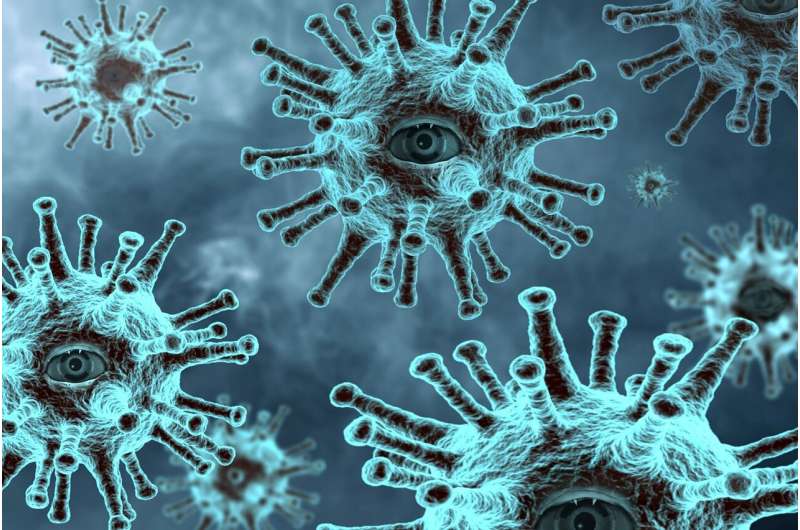Superinfections pose threat to those being treated for the coronavirus

Viral infections aren't the only cause of deaths during pandemics. A common complication of viral infections such as the flu or the coronavirus is a secondary, superimposed bacterial infection—or a superinfection—resistant to the treatment being used against the primary infection.
The complication of these superinfections is a silent component of cases and deaths and doesn't always receive attention. For instance, decades after the Spanish flu pandemic in 1918, several studies showed that many deaths were caused by bacterial superinfections.
While differences in laboratory testing a century ago and the lack of complete records make pinpointing exact causes of death difficult, experts generally attribute a lot of the deaths to complex pneumonia on top of the Spanish flu. While there is still little understanding of the internal damage caused by COVID-19 today, there is growing concern and knowledge about the potential risk of superinfections.
"Up to 50% of the deaths of people hospitalized on ventilators so far are actually a consequence of bacterial superinfections," said Julie Gerberding, current president of Merck's vaccine division and former director of the U.S. Centers for Disease Control and Prevention. "It's a force of mortality that we need to pay more attention to."
In simple terms, the patients with COVID-19, whether on ventilators or in the intensive care unit, are severely ill and unable to ward off infections as easily. This predisposes them to developing additional infections.
"They often have not only ventilation tubes but other catheters and devices that set the stage for hospital bacteria to start infections," Gerberding said.
Furthermore, COVID-19 patients tend to be in the hospital for a long time and there is a greater opportunity to come into contact with bacteria. Antibiotics are commonly prescribed to prevent patients from developing secondary infections, but they don't always work.
"Superinfections are very difficult to treat. Not all hospitals have the antibiotics needed on hand, and because we don't have a robust pipeline of new antibiotics they're difficult to treat effectively," Gerberding said. "Just when you thought it was about the virus, there's more to it."
What complicates the discussion about superinfections and COVID-19 is recent evidence from two mouse studies published in Science that shows that a potential therapy being evaluated in clinical trials for COVID-19—interferons—may increase susceptibility to bacterial infections depending on how long and how much a patient was exposed. Interferons are a type of molecule naturally released by the body, with specific types designed to kill viruses. Scientists have studied their potential for years as a type of antiviral treatment.
"There are three families of interferons. Type 1 and Type 3 are known for their antiviral properties," said Ivan Zanoni, assistant professor of pediatrics at Harvard Medical School and senior investigator of one of the studies published in Science.
Type 3 interferons have attracted interest as a potential treatment for COVID-19 because compared to Type 1 interferons, they are less potent but longer acting.
"Our research shows that a prolonged exposure to Type 3 Interferons can cause a problem to the host," Zanoni said.
The specific problem concerns unwanted damage to the lungs. Two studies showed that in mice, a prolonged exposure to Type 3 interferons can reduce the ability of cells in the lung to recover from damage. These cells, specifically epithelial cells, serve as important gatekeepers that prevent the lungs from being infected by bacteria.
"Any breakdown of this epithelial barrier is going to predispose someone to bacterial superinfections," said Alison Carey, associate professor of microbiology, immunology, and pediatrics at Drexel University College of Medicine. "These studies emphasize the need to find a delicate balance between the need to kill the virus and prevent the long-term negative associations."
But finding the exact timing and duration of treatment can be a challenge.
"The main problem is you don't know when your patient was infected. You have a vague idea of when their symptoms started, and you ideally need to treat people as early as you can," said Andreas Wack, group leader at the Francis Crick Institute and senior author of the other interferon study published in Science. "But later in the infection is when the repair of the lungs needs to happen, and when there are still interferons sticking around, this can be a problem."
Experts emphasize that the therapeutic benefit of interferon-based and other emerging treatments needs to be investigated closely, and the long-term and permanent effects on the lungs, whether from COVID-19 or treatments such as interferon are still unknown.
"Even when we find a vaccine, the COVID story will not end because there may be long-term effects—potentially increases in cases of COPD (chronic obstructive pulmonary disease) and other antibiotic resistant bacterial infections," Wack said.
"There's a lot that is unknown about what the long-term consequences are going to be for the COVID-19 pandemic," Carey said. "We can look at other respiratory infections to give us an idea of what we have ahead of us, but in terms of prognosis and long-term complications, we don't know yet."
©2020 The Philadelphia Inquirer
Distributed by Tribune Content Agency, LLC.




















